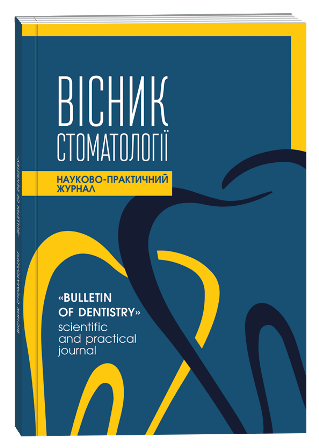PREDICTION OF INTRAAND POSTOPERATIVE COMPLICATION RISKS OF LATERAL SINUS FLOOR AUGMENTATION BASED ON MULTIFACTORIAL MODELS OF LOGISTIC REGRESSION: A PROSPECTIVE ANALYSIS OF 310 OPERATIONS
DOI:
https://doi.org/10.35220/2078-8916-2024-51-1.25Keywords:
Lateral sinus floor augmentation, perforation, sinusitis, complications, risk factors, dental implantation, patient-specific implants.Abstract
Objective of the study. Determine the frequency of perforations (P) of the mucoperiosteum of the maxillary sinus (MS), acute and chronic sinusitis (S), as well as the loss of bone-replacement material in patients undergoing lateral sinus floor augmentation (LSFA) for tooth row defects in the lateral sections of the upper jaw (UJ), and also identify the risk factors for these complications. Materials and methods of the study. The study involved 240 patients with a deficiency in the bone proposition of the alveolar process of the upper jaw (≤4 mm.) in the distal section, who required LSFA procedures for further restoration of masticatory efficiency with prosthetic constructions on dental osseointegrating implants. Statistical analysis involved identifying factors associated with an increased risk of complications in the early and late postoperative periods. The analysis of the complication risk in patients after LSFA was based on the univariate logistic regression models, for each factor, as well as a multifactorial analysis with the ROC curves, calculated using the EZR program (v.1.54). Study results: 240 patients (54 % women – 130 patients) underwent 310 LSFA procedures. The average age was 50.7±7.39. Seventy-seven patients (32 %) were smokers. Unilateral LSFA was performed on 170 patients (71 %). Left-sided LSFA was performed on 165 patients (53 %). The reason for tooth loss: 214 cases (69 %) were due to caries, periodontal diseases in 68 cases (21 %), and trauma in 28 cases (10 %). Xenogenic bonereplacement materials were used in 278 cases (89.7 %), while autologous bone blocks were used in the other 32 cases (10.3 %).Complications in the form of acute and/ or chronic sinusitis developed in 17 patients (7 %) in 21 operated sinuses. However, in 9 cases (3 %), the adverse course of inflammatory processes led to complete loss of the bone graft and failure of the pre-implantation preparation. Conclusions. The frequency of intra- and postoperative complications in patients undergoing LSFA as part of the pre-implantation preparation in this series was as follows: perforation of the mucoperiosteum of the maxillary sinus – 32%, acute and chronic maxillary sinusitis – 7 %, complete loss of the graft due to an infectious purulent-inflammatory process – 3 %. The increased risk of mucoperiosteum perforation was associated with the category of septa, the position of the vascular anastomosis, the presence of bleeding, and the thickness of the anterior bone wall of the maxillary sinus (p<0.05). The four-factor model we proposed for predicting perforation is characterized by a very strong association with an AUC = 0.83 (95 % CI 0.78 – 0.88), and the five-factor model for predicting the risk of maxillary sinusitis at an AUC = 0.91 (95 % CI 0.86 – 0.96) can be used in planning treatment measures in patients with tooth row defects in the distal sections of the maxillary sinus.
References
Tatum, H. (1986). Maxillary and sinus implant reconstructions. Dental Clinics of North America, 30, 207-29.
Boyne, P., & James, R.A. (1980). Grafting of the maxillary sinus floor with autogenous marrow and bone. Oral and Maxillofacial Surgery, 17,113-116.
Woo, I, & Le, B.T. (2004). Maxillary sinus floor elevation: review of anatomy and two techniques. Implant Dent,13, 28–32.
Iwanaga, J., Wilson, C., Lachkar, S., Tomaszewski, K.A., Walocha, J.A., & Tubbs, R.S. (2019). Clinical anatomy of the maxillary sinus: application to sinus floor augmentation. Anat Cell Biol., 52(1),17-24 doi: 10.5115/acb.2019.52.1.17.
Van den Bergh J.P, ten Bruggenkate C.M, Disch. F.J., & et al. (2000). Anatomical aspects of sinus floor elevations. Clin Oral Implants Res, 11(3), 256–65.
Cawood, J.I., & Howell, R.A. (1988). A classification of the edentulous jaws. Int J Oral Maxillofac Surg, 17(4), 232-6 doi: 10.1016/s0901-5027(88)80047-x.
Al-Faraje L. (2011). Surgical Complications in Oral Implantology, First. ed, Quintessence. Hanover Park, Illinois.
Chen, Y.-W., Lee, F.-Y., Chang, P.-Ch., Huang, Ch. -Ch., Fu Ch. -H. & et al. (2018). A paradigm for evaluation and management of the maxillary sinus before dental implantation. Laryngscope, 128(6), 1261–1265 doi: 10.1002/lary.26856.
Kanda, Y. (2013). Investigation of the freely available easy-to-use software ‘EZR’ for medical statistics. Bone Marrow Transplant, 48:452–458. doi:10.1038/ bmt.2012.24.
Jordi, C., Mukaddam, K., Lambrecht, J.T., & Kühl, S. Membrane perforation rate in lateral maxillary sinus floor augmentation using conventional rotating instruments and piezoelectric device -a meta-analysis. Int J Implant Dent. 2018;4(1), 1 – 9 doi: 10.1186/s40729-017-0114-2.
Lozano-Carrascal, N., Salomó-Coll, O., Gehrke, S.A., Calvo-Guirado, J.L., Hernández-Alfaro, F., & Gargallo- Albiol, J. (2017). Radiological evaluation of maxillary sinus anatomy: A cross-sectional study of 300 patients. Ann Anat. 214, 1-8 doi: 10.1016/j.aanat.2017.06.002
Shlomi, B., Horowitz, I., Kahn, A., & et al. (2004). The effect of sinus membrane perforation and repair with Lambone on the outcome of maxillary sinus floor augmentation: A radiographic assessment. Int J Oral Maxillofac Implants, 19, 559-562.
Proussaefs, P., Lozada, J., Kim, J., & et al. (2004). Repair of the perforated sinus membrane with a resorbable collagen membrane: A human study. Int J Oral Maxillofac Implants, 19, 413-420 PMID: 15214227
Tükel, H. C., & Tatli, U. (2018). Risk factors and clinical outcomes of sinus membrane perforation during lateral window sinus lifting: analysis of 120 patients. Int J Oral Maxillofac Surg, 47(9):1189-1194 doi: 10.1016/j. ijom.2018.03.027
Schwarz, L., Schiebel, V., Hof, M., Ulm, C., Watzek, G., & Pommer, B. (2015). Risk Factors of Membrane Perforation and Postoperative Complications in Sinus Floor Elevation Surgery: Review of 407 Augmentation Procedures. J Oral Maxillofac Surg, 73(7), 1275-82 doi: 10.1016/j.joms.2015.01.039.
Barbato, L., Baldi, N., Gonnelli, A., Duvina, M., Nieri, M., & Tonelli, P. (2018). Association of Smoking Habits and Height of Residual Bone on Implant Survival and Success Rate in Lateral Sinus Lift: A Retrospective Study. J Oral Implantol, 44(6), 432-438 doi: 10.1563/aaidjoi- D-17-00192.
Yang, D., & Lee N. A. (2021). Simple Method of Managing the Alveolar Antral Artery during Sinus Lift Surgery. International Journal of Otolaryngology and Head & Neck Surgery, 10, 131-146 doi: 10.4236/ ijohns.2021.103014









